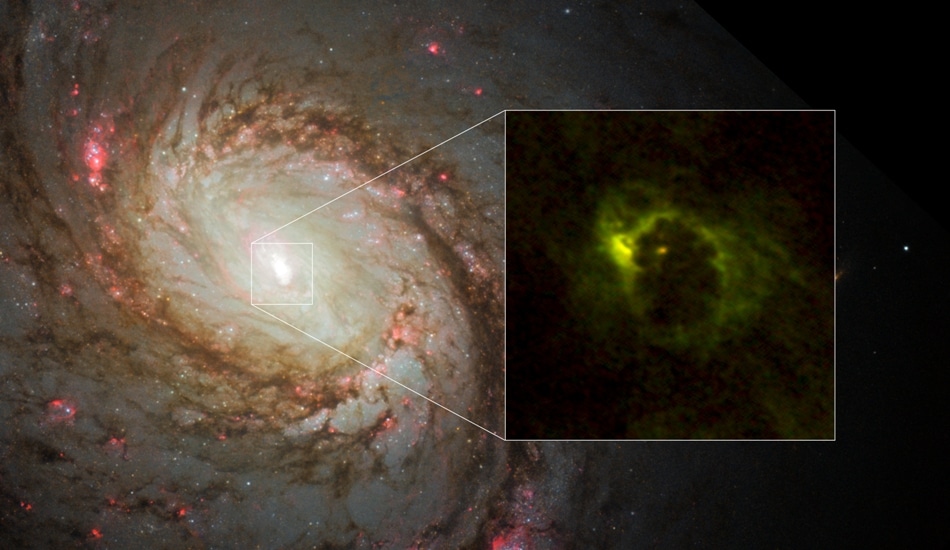Feb 16 2018
Astronomers utilized the high resolution of the Atacama Large Millimeter/submillimeter Array (ALMA) to observe rotating donut-like structures of dusty gas around an active supermassive black hole.
 The central region of the spiral galaxy M77. ALMA imaged a horseshoe-like structure with a radius of 700 light-years and a central compact component with a radius of 20 light-years. The latter is the gaseous torus around the AGN. Red indicates emission from formyl ions (HCO+) and green indicates hydrogen cyanide emission. (Image credit: ALMA (ESO/NAOJ/NRAO), Imanishi et al., NASA/ESA Hubble Space Telescope and A. van der Hoeven)
The central region of the spiral galaxy M77. ALMA imaged a horseshoe-like structure with a radius of 700 light-years and a central compact component with a radius of 20 light-years. The latter is the gaseous torus around the AGN. Red indicates emission from formyl ions (HCO+) and green indicates hydrogen cyanide emission. (Image credit: ALMA (ESO/NAOJ/NRAO), Imanishi et al., NASA/ESA Hubble Space Telescope and A. van der Hoeven)
Years ago, the existence of such rotating donuts-shape structures was initially proposed, but this is the first time where such a structure has been seen so clearly. The study marks a major step in providing a better understanding about the co-evolution of supermassive black holes as well as their host galaxies.
The centers of nearly all galaxies have hidden massive black holes. For a long time, researchers have known that when the galaxy is more massive, the central black hole also becomes equally massive. While this sounds plausible in the beginning, host galaxies are in fact 10 billion times larger than the central black holes; two objects of such widely different scales would it find it difficult to directly impact each other. So, the question is how could such a relationship develop?
In an attempt to solve this shadowy mystery, astronomers used the high resolution of ALMA to observe the center of the spiral galaxy called M77. An “active galactic nucleus,” or AGN, forms the central area of M77. AGN means that matter is forcefully falling toward the central supermassive black hole and producing strong light. Since AGNs can considerably impact the surrounding environment, they are critical objects for solving the mystery of the co-evolution of black holes and galaxies.
After imaging the area around the supermassive black hole in the M77 galaxy, the astronomers resolved a small gaseous structure with a radius of 20 light-years. They discovered that the dense structure is rotating around the massive black hole, as predicted.
To interpret various observational features of AGNs, astronomers have assumed rotating donut-like structures of dusty gas around active supermassive black holes. This is called the ‘unified model’ of AGN. However, the dusty, gaseous donut is very tiny in appearance. With the high resolution of ALMA, now we can directly see the structure.
Masatoshi Imanishi, Lead Author (National Astronomical Observatory of Japan)
While the center of the M77 galaxy has been observed by many astronomers before, this is the first time where the rotation of the dusty, gaseous donut around the black hole has been observed so clearly.
In addition to the superior resolution of ALMA, the choice of molecular emission lines to visualize was central to exposing the structure. The astronomers observed particular microwave emission from formyl ions (HCO+) and hydrogen cyanide molecules (HCN). While these molecules produce microwaves only in dense gas, the carbon monoxide (CO) which is observed more frequently, emits microwaves under a wide range of conditions [1]. The gaseous torus around the AGN is believed to be extremely dense, and the strategy of the team was right on track.
Previous observations have revealed the east-west elongation of the dusty, gaseous torus. The dynamics revealed from our ALMA data agrees exactly with the expected rotational orientation of the torus.
Masatoshi Imanishi, Lead Author (National Astronomical Observatory of Japan)
An interesting fact is that the gas which is distributed around the supermassive black hole is much more complex than what a basic unified model indicates. The gaseous torus appears to have asymmetry, the rotation, and the rotation in addition to following the gravity of the supermassive black hole also contains highly arbitrary motion. These facts could suggest that the AGN had an intense history, potentially including fusion with a small galaxy [2]. However, the identification of the rotating gaseous torus represents a major step.
A supermassive black hole is also present in the center of the Milky Way Galaxy, where humans live, but this black hole is in a very dormant state. In fact, only a small amount of gas is accreting onto it. Hence, to comprehensively study an AGN, astronomers have to closely observe the centers of distant galaxies. As one of the nearest AGN, M77 is an appropriate object for detailed observation of the very center.
Paper and Research Team
These observation results were published as Imanishi et al. “ALMA Reveals an Inhomogeneous Compact Rotating Dense Molecular Torus at the NGC 1068 Nucleus” in the Astrophysical Journal Letters (2018 February 1 issue, 853, L25).
The research team members are:
Masatoshi Imanishi (National Astronomical Observatory of Japan/SOKENDAI), Kouichiro Nakanishi (National Astronomical Observatory of Japan/SOKENDAI), Takuma Izumi (National Astronomical Observatory of Japan), and Keiichi Wada (Kagoshima University)
The Japan Society for the Promotion of Science KAKENHI (Grant Numbers 15K05030 and 16H03959) supported the research.
[1] García-Burillo et al. (2016) observed the distribution and motion of CO with ALMA and did not find clear rotation along the east-west torus direction. Their interpretation is that the turbulent motion is so intense that the east-west oriented rotating motion is not clear. Gallimore et al. (2016) also observed CO emission and found gas motion in the north-south direction. They interpret this as outflowing gas from the black hole.
[2] Recently, astronomers used the Subaru Telescope to observe M77 and revealed signatures of a merger with a small galaxy billions of years ago. For details, please read the press release “Minor Merger Kicks Supermassive Black Hole into High Gear” issued in October 2017 from the Subaru Telescope.